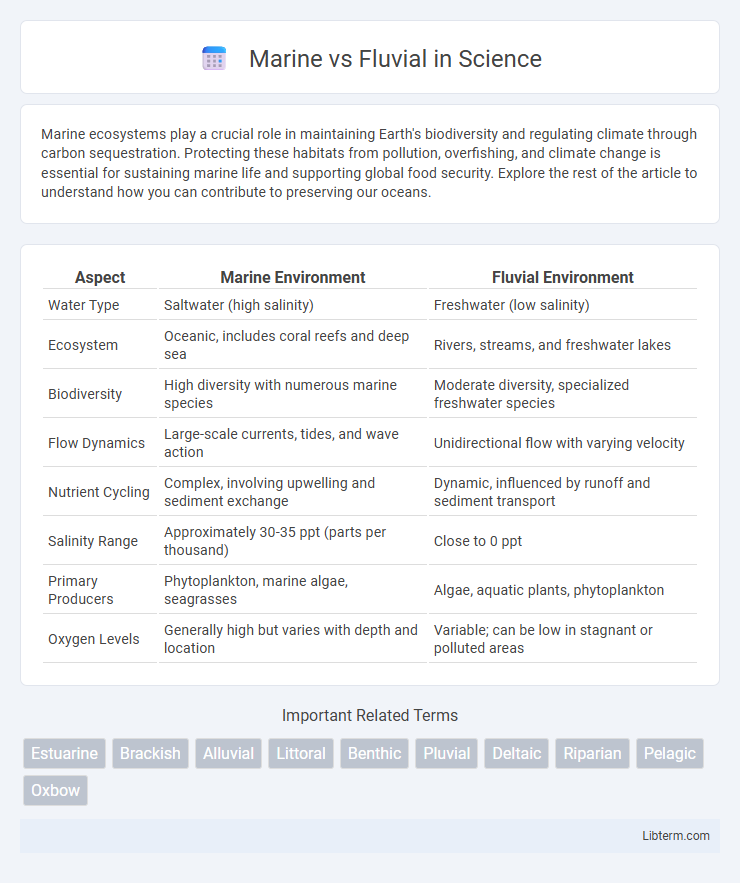Marine ecosystems play a crucial role in maintaining Earth's biodiversity and regulating climate through carbon sequestration. Protecting these habitats from pollution, overfishing, and climate change is essential for sustaining marine life and supporting global food security. Explore the rest of the article to understand how you can contribute to preserving our oceans.
Table of Comparison
| Aspect | Marine Environment | Fluvial Environment |
|---|---|---|
| Water Type | Saltwater (high salinity) | Freshwater (low salinity) |
| Ecosystem | Oceanic, includes coral reefs and deep sea | Rivers, streams, and freshwater lakes |
| Biodiversity | High diversity with numerous marine species | Moderate diversity, specialized freshwater species |
| Flow Dynamics | Large-scale currents, tides, and wave action | Unidirectional flow with varying velocity |
| Nutrient Cycling | Complex, involving upwelling and sediment exchange | Dynamic, influenced by runoff and sediment transport |
| Salinity Range | Approximately 30-35 ppt (parts per thousand) | Close to 0 ppt |
| Primary Producers | Phytoplankton, marine algae, seagrasses | Algae, aquatic plants, phytoplankton |
| Oxygen Levels | Generally high but varies with depth and location | Variable; can be low in stagnant or polluted areas |
Introduction: Defining Marine and Fluvial Environments
Marine environments encompass vast saltwater ecosystems such as oceans, seas, and coastal areas characterized by high salinity and tidal influences. Fluvial environments refer to freshwater systems including rivers, streams, and floodplains where water flow shapes the landscape and sediment transport plays a crucial role. Understanding the distinction between these environments is essential for studies in ecology, geology, and hydrology.
Key Differences Between Marine and Fluvial Systems
Marine systems are characterized by saltwater environments like oceans and seas, influenced by tides, waves, and ocean currents, supporting diverse ecosystems such as coral reefs and deep-sea habitats. Fluvial systems consist of freshwater rivers and streams, shaped by processes like erosion, sediment transport, and deposition, creating features such as floodplains and river deltas. Key differences include salinity levels, flow dynamics, sediment types, and ecological communities adapted to either marine or freshwater conditions.
Geographical Distribution and Global Importance
Marine environments dominate about 71% of Earth's surface, primarily covering oceans and seas that play a crucial role in global climate regulation and biodiversity support. Fluvial systems, comprising rivers and streams, are concentrated in continental interiors and coastal zones, providing essential freshwater resources and sustaining agricultural and urban populations worldwide. The global importance of marine systems lies in their influence on carbon cycling and fisheries, while fluvial networks are vital for nutrient distribution, freshwater supply, and habitat connectivity.
Physical Characteristics of Marine vs Fluvial Habitats
Marine habitats are characterized by high salinity, vast open water, and diverse depth zones from intertidal areas to deep ocean trenches, influencing unique adaptations in flora and fauna. Fluvial habitats consist of freshwater systems such as rivers and streams, with variable flow rates, sediment loads, and oxygen levels shaping distinct ecological communities. Physical factors like current velocity, substrate type, and water chemistry play critical roles in determining species distribution and habitat structure in both marine and fluvial environments.
Biodiversity: Marine Life Versus Freshwater Species
Marine ecosystems host approximately 230,000 known species, featuring diverse habitats such as coral reefs and deep-sea vents that support complex food webs and high biodiversity levels. Freshwater systems, while covering less than 1% of the Earth's surface, contain around 100,000 species adapted to rivers, lakes, and wetlands, including many endemic and threatened species. The contrast in salinity, temperature, and habitat structure creates distinct biotic communities, with marine environments generally exhibiting higher species richness and biomass compared to freshwater ecosystems.
Major Ecosystem Services Provided by Each Environment
Marine ecosystems provide critical services including carbon sequestration, biodiversity support for fisheries, and coastal protection through coral reefs and mangroves. Fluvial ecosystems contribute essential services such as freshwater purification, nutrient cycling, and habitat connectivity for migratory fish species. Both environments sustain human livelihoods by supporting agriculture, drinking water supplies, and tourism, emphasizing their unique yet complementary ecological roles.
Human Activities and Their Impact on Marine and Fluvial Systems
Human activities such as shipping, fishing, and coastal development significantly impact marine systems by causing habitat destruction, pollution, and overexploitation of marine resources. In fluvial environments, activities like agriculture, dam construction, and urbanization alter river hydrology, increase sedimentation, and degrade water quality, threatening freshwater biodiversity. Both marine and fluvial systems face challenges from nutrient runoff and chemical contaminants, leading to eutrophication and loss of ecological balance.
Sediment Transport and Landform Formation
Marine sediment transport involves the movement of sediments by ocean currents, tides, and waves, shaping coastal features like beaches, deltas, and continental shelves. Fluvial sediment transport is dominated by river flow dynamics, carrying sediments downstream to form alluvial fans, floodplains, and river deltas. Both processes are critical in landscape evolution, with marine systems redistributing sediments along shorelines and fluvial systems delivering terrestrial materials to marine environments.
Climate Change Effects on Marine and Fluvial Environments
Climate change intensifies sea level rise and ocean acidification in marine environments, disrupting coral reefs and marine biodiversity. Fluvial environments face altered river flow patterns and increased flooding frequency due to changing precipitation and glacial melt. Both settings experience ecosystem stress, but marine systems endure increased water temperature and salinity shifts, while fluvial zones confront sediment transport changes and water quality degradation.
Conservation Strategies for Marine and Fluvial Ecosystems
Conservation strategies for marine ecosystems emphasize protecting coral reefs, enforcing marine protected areas, and regulating fishing practices to preserve biodiversity and maintain fish populations. Fluvial ecosystem conservation prioritizes restoring natural flow regimes, preventing river pollution, and safeguarding riparian buffers to sustain freshwater species and improve water quality. Both systems benefit from integrated watershed management and community engagement to enhance ecosystem resilience and mitigate human impacts.
Marine Infographic

 libterm.com
libterm.com